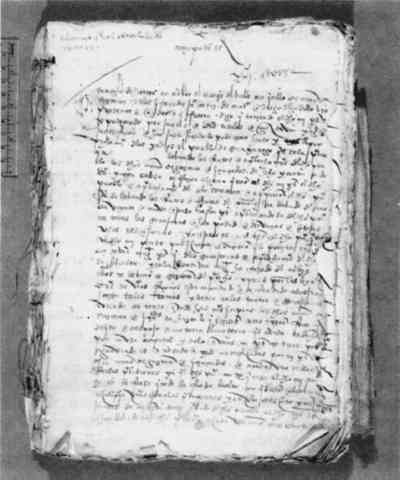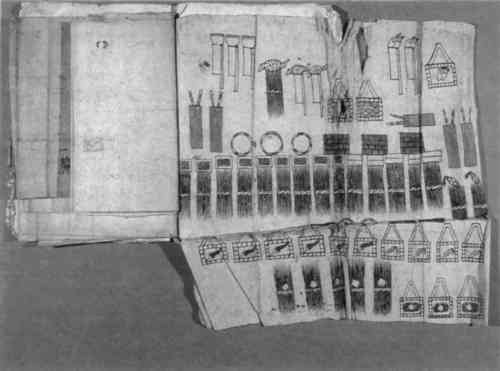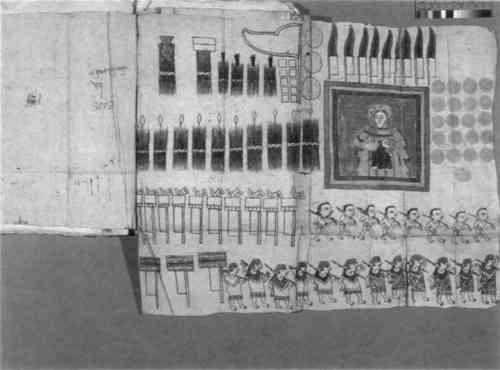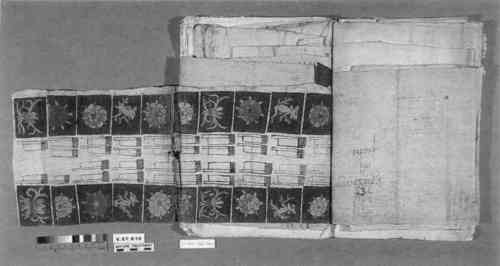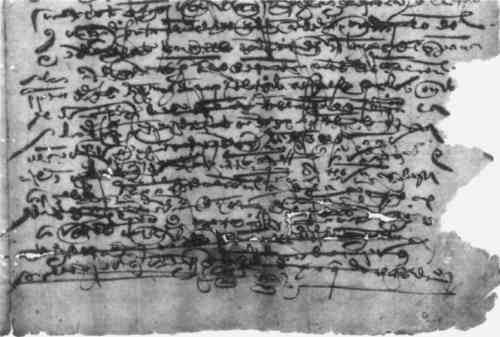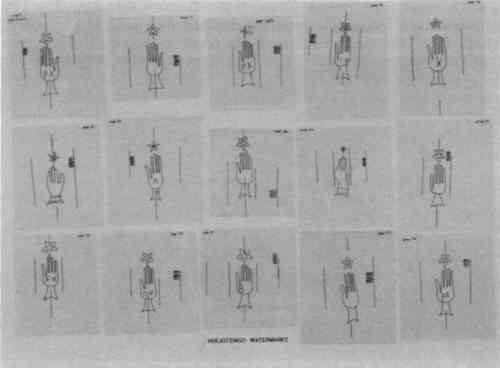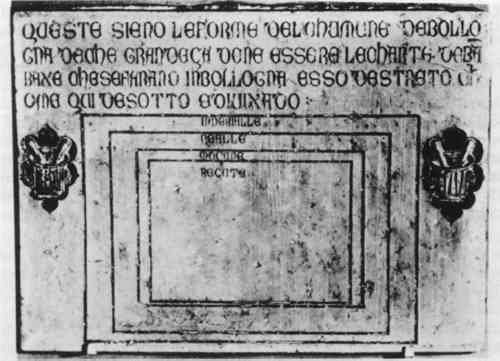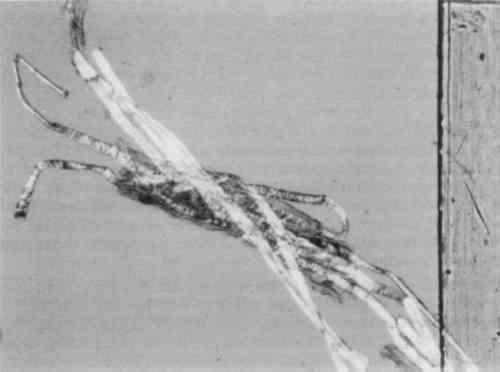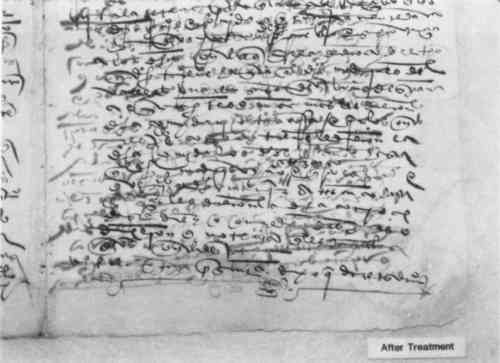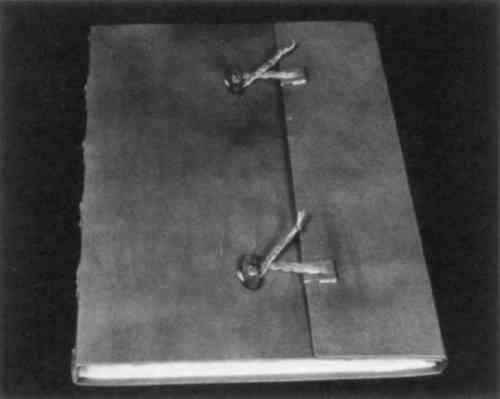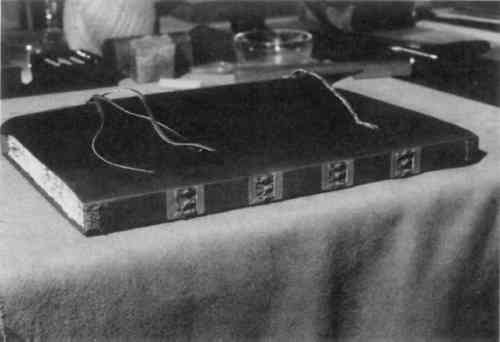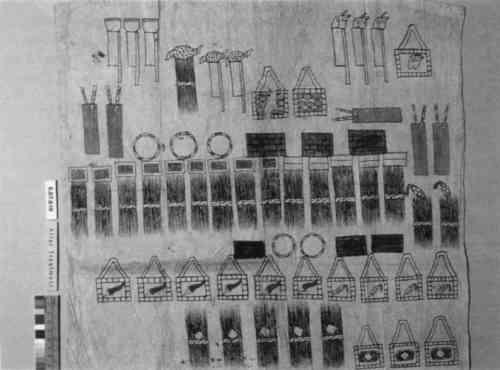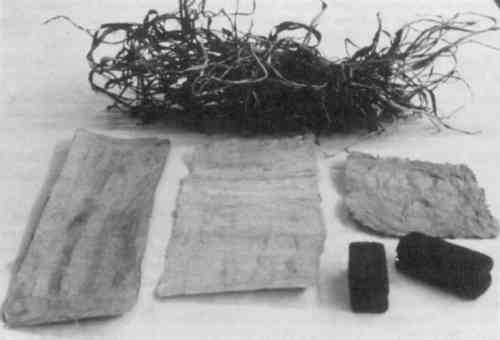THE EXAMINATION AND CONSERVATION TREATMENT OF THE LIBRARY OF CONGRESS HARKNESS 1531 HUEJOTZINGO CODEXSYLVIA RODGERS ALBRO, & THOMAS C. ALBRO
ABSTRACT—This article describes the technical examination and conservation treatment of an important manuscript from post-conquest Mexico that contains eight fold-out Indian pictographs from Huejotzingo on native papers. Examination includes a study of the native Indian and western papers, inks, pigments, sewing structure, collation, and format. Conservation treatment of the text includes disbinding, treatment of the text with nonaqueous deacidification, reversal of silking, mending, and rebinding. Treatment of the Indian drawings includes consolidation, flattening, and mending. An adaptation of the traditional technique of Mexican papermaking is used for mending the drawings. A study of early 16th–century bindings at the Archivo General de la Naci�n in Mexico City is used to aid in the design of the new binding for the Library of Congress manuscript. 1 INTRODUCTIONALONG WITH the Library of Congress's most valuable and important collection of Spanish American manuscripts and documents, the 1531 Huejotzingo Codex (fig. 1) was presented to the Library by the American philanthropist Edward Stephen Harkness in 1928–29 (Library of Congress 1974, v). The 79-leaf manuscript includes eight Mexican Nahuatl pictographs sewn into the center of the binding and consists of the proceedings of a lawsuit brought by Hernando Cort�s against members of the first audiencia (supreme court) of Mexico in 1531–32. Three Spaniards were accused of attempting to take over Cort�s's properties and powers in Mexico during his return visit to Spain in 1528 (Library of Congress 1974, 49). These Spaniards are identified as Nu�o de Guzm�n, president of the first audiencia in Mexico, and licentiates Juan Ortiz de Matienzo and Diego Delgadillo, oidores. Cort�s charged that during his absence the president and oidores (judges) of the first audiencia unjustly and improperly collected for themselves the tributes of goods and services that belonged to Cort�s from the Indians of the town of Huejotzingo.1 Specific details of the tributes and services that the Indians were forced to give the accused in Cort�s's absence are shown on the eight paintings on native papers (figs. 2, 4, 8). These unusual pictographs give the manuscript the ethnohistorical designation of “codex,” which differs from the definition of “codex” used by conservators and librarians. The former focuses on pictorial content, and the latter on book structure and format.2 One of the most interesting images is a Nahuatl illustration of the Christian Madonna and child, which the manuscript text describes as the design for a banner made by the Indians for Nu�o de Guzm�n, a conquistador, and which is one of the earliest extant Christian images made in the New World (fig. 4) (Library of Congress 1974, 109).3
The mest�zo character of the manuscript—the combination of both European and Indian accounts of early events in 16th–century Mexican history—gives the piece a Until 1925, the 1531 Huejotzingo Codex was part of the private archive belonging to the descendants of Cort�s (the Italian dukes of Monteleone) and was housed in the Hospital de la Immaculada Concepci�n y de Jes�s Nazareno in Mexico City together with other documents related to Cort�s and his family. Sometime after 1925 the manuscript was sold along with other papers by a Monteleone descendant to the dealer A.S.W. Rosenbach, who then sold a partial collection of the papers to Harkness. What remains of the Hospital de Jes�s archive is Mexican national property and can be found in the Archivo General de la Naci�n in Mexico City. 2 CONDITION PRIOR TO TREATMENTTHE HUEJOTZINGO CODEX was brought to the attention of the Library of Congress's Conservation Office for examination in 1986 by the Manuscript Division because the manuscript was in poor condition and thus unavailable to scholars for study. It consisted of three parts: 1) 74 foliated leaves of Spanish text written in brown ink on antique laid paper—side-stitched together; 2) five loose leaves of the same text that had been silked; and 3) eight fold-out Indian drawings in color on native-made papers sewn into the center of the manuscript. The manuscript was housed in a box that was too large, so that the parts shifted around easily. Handling had already soiled, curled, and torn many of the leaves, and any additional handling risked further damage. Some of the writing inks used throughout the Spanish text were very acidic and had eaten through the paper extensively (fig. 6). A pile of broken fragments had collected in the bottom of the storage box. The tight sewing structure was actively damaging both the European and Mexican papers and prevented the manuscript from opening easily and lying flat. As a result, a microfilm of the manuscript made in 1942 did not show the writing closest to the spine. A number of the text pages had torn loose from the binding.
The Indian papers were delicate, and repeated unfolding and folding to fit into the manuscript format had caused wearing and fraying along the fold lines. Pigments from the drawings were crumbling and brittle along the fold lines as well. The silked leaves had a flat character completely different from that of the text. The writing was obscured and difficult to read. In addition, leaves had been joined and silked in a form that did not follow the correct collation order. The rarity and exceptional quality of the manuscript made it an excellent candidate for detailed study. A close examination undertaken by the Conservation Office with the cooperation of the Library's Manuscript and Hispanic divisions produced a proposal for the conservation treatment of the codex and simultaneously disclosed a wealth of information about the materials and practices used by both Spanish and Indian cultures in the early colonial period in Mexico. 2.1 COLLATION AND SEWINGTHE MANUSCRIPT was sewn in legajo form (sections side-stitched along the spine edge) with at least six different kinds of sewing threads.4 These included red, green, and buff-colored loose twist threads that intersected repeatedly throughout the text. It is likely that the manuscript had been reorganized on occasion, as several of the threads were loose fragments with no sewing purpose and a number of leaves distributed throughout the text had additional sets of sewing holes, indicating a previous sewing. As the lengthy lawsuit proceeded, accumulated material was probably added to the manuscript periodically. The number of leaves in each section varied from one leaf to seven foliated leaves. The sections were sewn into bundles, which pulled and rubbed against each other unevenly when the manuscript was handled. The Indian drawing papers were sewn into the manuscript with a dark green thread not found elsewhere in the sewing structure. Tension at the sewing points had caused tearing of the drawing papers. 3 MANUSCRIPT TEXTVARIOUS ANTIQUE laid papers make up the text. They were identified as linen fiber by polarized light microscopy. A technical study of the paper revealed 16 different watermarks (fig. 10), all of the same “hand” or “gauntlet” design as that used in the 16th-century Italian papermaking industry in Genoa (Briquet 1955), a documented source for papers used by the Spanish in early Mexican colonial manuscripts (Mena 1926; Briquet 1955). Most of the conjugate leaves have deckled edges on four sides, indicating that they are whole, uncut sheets. They measure 31.8 � 43.6 cm, which corresponds exactly to the size described as re�ute (small) by a 14th-century papermaker's stone from Bologna, which exhibits incised sheet sizes (fig. 11).5 By the 16th century, the Italian papermaking industry was well organized, which explains why many of the papers used by the Spanish courts were from Italy and not Spain. A study of related Cort�s family papers in the
The text contains various dark brown inks written in at least 10 different calligraphies, as arguments on both sides of the case were presented and recorded by different hands. Based on records documenting ink used in the period, as well as the appearance and acidity of the manuscript ink, it is most probable that the ink contains iron (de Pas and Flieder 1976). The condition of the individual sheets was dependent upon the character and quantity of ink present. In one section of the manuscript (leaves 20–34), the ink was exceedingly acidic and had created many holes in the paper. These leaves could not be turned without losing fragments. The writing showed such extensive strike-through to the opposite side of the page that legibility was impaired. The most severe areas of damage had been mended with pressure-sensitive tape before 1942,7 and the adhesive subsequently had penetrated the paper, causing embrittlement and severe discoloration. The writing was completely illegible in these areas. Other sections of the manuscript exhibited similar ink damage but to a lesser degree. Discoloration was slight on leaves with little or no ink, and these pages were still quite flexible. The bottom edge of the manuscript was water damaged, blurring the writing in these areas. The paper color in general is an even, creamy white, and the surface pH measured from 5.6 to 6.0.8 Despite the tight sewing, exposure to handling, and acidic inks, the manuscript paper had withstood these damages and survived 500 years of natural aging because of its fine quality. The moderate climate of Mexico City, where the manuscript resided until 1929, also contributed to its survival. 4 SILKED PAGESTHE FIRST and last pages of the manuscript had become separated from the sewn text many years ago. Due to their greater exposure to handling and the lack of protective covers in the structure of the manuscript, they had sustained the most damage and were first selected by the Library of Congress to receive treatment by the Government Printing Office in the 1940s (Library of Congress case file, n.d.). Large areas of loss in each leaf were filled with laid paper before Cr�peline (a French close-weave transparent silk) was applied with a starch adhesive to both sides of the leaves. The leaf paper was the same as the rest of the sewn manuscript; however, the treatment had greatly altered its appearance and texture. The silking was done on top of considerable surface soil. Sheets had a placemat quality and were brittle and stiff. Corners of the paper bent easily. Surface pH of these leaves measured approximately 4.0. Because the pH meter records only surface pH, it was difficult to determine whether the measurement referred only to the applied silk or to the paper underneath as well. When compared to a new, unused piece of Cr�peline from the same source (pH 4.6), the old fabric had discolored to a dark brown. Original sewing holes could be detected in transmitted light examination. In spite of drawbacks, silking did save these manuscript leaves from further loss in the last 45 years. Examination of the microfilm from the 1940s showed that untreated leaves in the manuscript had subsequently lost fragments of text. Nevertheless, a better solution for the treatment of the manuscript text was necessary. 4.1 DRAWINGSThe drawings were carefully and colorfully executed on fibrous native Mexican papers of various sizes, all larger than the manuscript text paper. Upon examination two distinctly
Both papers are skillfully made, regular and even in texture. Dimensions vary from 19.7 � 48.3 cm to 44.5 � 45.7 cm. The amatl paper is made from soaked and boiled inner bark fiber pounded with stone and looks like a highly worked and refined tapa cloth. It is light brown in color. A texture of corrugated lines from the stones used for beating is a feature of this stretchy, delicate paper. The maguey paper, made from the inside of the leaves of the agave cactus, has a more silvery white color than the amatl and a thicker, more even texture. It is also a beaten paper but does not have the corrugated lines of the amatl. The authors gained a fine appreciation for the craft of the Huejotzingo Indian papermakers after attempting with only partial success to reproduce similar papers from Mexican amatl fibers obtained from a modern papermaker.11 Colors used in the Nahuatl drawings were black, red, yellow, orange, green, brown, and blue. A white pigment, identified as calcium carbonate, was mixed in with many of the colors. The black is identified as a very fine charcoal. Polarized light microscopy was used to identify these pigments. Other colors appear to be organic in nature and are more difficult to identify precisely. Original sources suggest a varied organic palette for the scribe or artist of the Aztec period (de Sahag�n 1963, pt. 12:239–46). The vivid red pigment that appears in many of the designs is probably cochineal, a color noted for its widespread use in this area of Mexico (fig. 8) (Aguilera 1985, 92; de Sahag�n 1963, 12:239–46).12 Sources describe the pigment binder most commonly used by Indians in Mexico during the colonial period and before as tzacuhtli, a natural adhesive similar to gum arabic or cherry gum, obtained from the roots of an orchid plant (Epidendrum pastoris La Llave et Lex.) (Mart�nez-Cortez 1970; Hern�ndez 1942–46, 1: chap. 128, 2: chaps. 80, 84). Folding and unfolding the drawings during use created a need for consolidation of crumbling pigment in the creases. In areas not directly affected by the stresses of use, the pigments are well adhered to the paper. Case file notes from the Library of Congress Manuscript Division indicate that the manuscript was on permanent exhibit for 12 years, from 1930 to 1942. Considering that the pigments are primarily organic, it is remarkable that the colors remain bright and vibrant despite this long period of exhibition. Sewing the drawings into the Spanish text resulted in mixed benefits for their preservation. They were folded to fit the smaller format of the text, creating pronounced creases and eventually tears and holes. On the other hand, they were never separated from their descriptive material or from each other as so many other drawings of the period have been, so their associative relationship with the text was preserved. Their placement within the manuscript protected them from exposure to light and dust. Examination with raking light revealed previous folds in the drawing papers, indicating a possible accordion pleat format before they were sewn into the manuscript. Surface pH measurement of the papers varied from 4.0 to 4.2. 5 CONSIDERATION OF TREATMENT OPTIONSTHE DECISION to alter an original format of a valuable artifact is reached only after careful consideration of a variety of conservation and curatorial concerns. The approved proposal for the Huejotzingo Codex called for disbinding the manuscript to conserve the text, removing the Indian drawings for treatment and separate housing, and reversing the silking in order to reintegrate the loose leaves with the text in the appropriate order. Numerous scholars of early Mexican manuscripts as well as Library curators were consulted during the formulation of the proposal. Not one historian objected to the removal of the drawings from the sewn format in order to better preserve them. Conservation of the codex was always considered to be of primary importance. Interestingly, a proposal to disbind the manuscript in order to improve the condition and housing of the drawings was first made to the Library in the mid-1940s by Stella R. Clemence, the Manuscript Division historian who first studied the Harkness collection.13 6 DOCUMENTATIONTHE CONDITION of the manuscript was fully documented with black-and-white and color photography before taking apart the sewing.14 Written and photographic records were kept throughout the treatment. 7 TREATMENT OF THE MANUSCRIPT TEXTTHE SEWING structure was taken apart by cutting the threads. The threads were saved for study, and a sewing model was constructed to illustrate the original structure. A new collation of the manuscript was made. Once the leaves had been separated, they were housed temporarily in polyester film sleeves for protection during handling and to permit a complete study of watermarks without fingering the papers. The leaves were lightly dry cleaned with grated Staedtler Mars plastic eraser crumbs. Tests with water and water-alcohol mixtures indicated that the ink would sink further in the paper with any aqueous treatment, adding to the difficulty of reading the text, which already showed considerable strike-through. Aqueous treatment also risked creating more breaks in the sections of already-riddled paper due to the physical stresses of expansion and contraction. A nonaqueous treatment was selected to give the material an alkaline reserve. The leaves were immersed in methyl magnesium carbonate solution (Library of Congress 1977), and this treatment brought the surface pH of the papers up to a range of 6.6–7.4. Leaves with pressure–sensitive tapes were treated first with tetrahydrafuran (THF). After peeling the dried tape carrier away, the leaves were immersed in the solvent to remove the adhesive. To remove additional adhesive staining the leaves were sprayed with THF locally using an air-brush and the suction table. Treatment of these leaves with the methyl magnesium carbonate followed the stain removal. Flexibility and ease of turning the leaves were considered top priorities in the practice of filling and mending. Edge tears and areas of loss in each leaf were repaired with Japanese papers, toned where necessary with Winsor & Newton acrylic pigments to match the original. With the help of a micrometer, layers of kizukishi, usumino, uda and tengujo paper were used to approximate the thickness of the manuscript paper (fig. 7). Determining the precise laminate structure for each fill was important so that new stresses would not be introduced when sections were sewn together again.
A number of different techniques were investigated for mending the ink-damaged papers. Library of Congress heat-set tissue, toned with acrylic pigments, was selected as 8 TREATMENT OF THE SILKED PAGESRESEARCH INTO the history of Library of Congress preservation practices uncovered the process used for the silking of documents in the 1940s. Manuscript papers were dampened and pressed, then pasted with a starch adhesive that also contained alum and white arsenic. The silk fabric was then applied to each side of the page and the whole pressed again (Fitzpatrick 1928, 36). As a result of this treatment the inks of the Huejotzingo manuscript on the leaves that had been silked were blurred and lightened and had sunk through to the opposite side of the page. Since these changes had already taken place, aqueous treatment of these leaves was considered. Testing indicated that the silking could be reversed in water. In water alone, however, the silk had to be peeled off, and a slight transfer of ink occurred. In addition, a substantial amount of adhesive remained on the paper. For these reasons, an alpha amylase enzyme solution was selected to detach the silk from the paper without transfer of ink (Segal and Cooper 1977).15 This treatment was very effective. After thorough rinsing and drying, the sheets could be examined closely. The paper was soft and gray-white in color compared to the cream color of the manuscript leaves that had never been treated. A strong impression of the silk weave remained on both sides of the paper. In order to improve the feel of the paper and strengthen it for subsequent rebinding, the leaves were sized by immersion in a 2% solution of warm gelatin after treatment in methyl magnesium carbonate solution. They remained a faded and worn version of their original character, demonstrating why silking has been replaced by other preservation techniques at the Library of Congress. Losses and tears were mended with Japanese papers as described previously. In addition, each individual leaf was joined to its correct original conjugate with laminate mends along the spine edges, using the size of the adjacent folio as a model. At this point a new microfilm of the manuscript was made that clearly shows all of the text. 9 REBINDINGTHE REPAIRED text, composed of sections and single leaves, was reorganized and guarded into a series of sections in order to sew through the folds. After other bindings of the period in the Library of Congress and the Mexican National Archives had been examined, a cover design was developed for the Huejotzingo manuscript. Alum-tawed goatskin was sprayed with Levaderm dye (an anionic metal complex) in an alcohol solution. A vellum wrapper was attached to the dyed goatskin using Jade 403 polyvinyl acetate as a heat-set adhesive. Slits were cut into the spine of the cover. These were reinforced on the outside with vellum sewing tackets. Sections were sewn with linen thread through the slits made in the cover (fig. 14). This nonadhesive binding holds a
10 TREATMENT OF THE DRAWINGSIT WAS first necessary to relax and flatten the drawings before mending could be accomplished. In general, the amatl papers were in poorer condition than the maguey papers and had more areas of loss and shredding where they had been folded. Each drawing was humidified in a chamber, and after about three hours of exposure, it could be unfolded and the large wrinkles gently pulled out. After humidification, each drawing was friction mounted between kizukishi lightweight Japanese paper and dried between thick (5/8 in) felts weighted with a piece of Plexiglas (Keyes 1984). Careful control of moisture during this process avoided disturbing the pigments. The Japanese papers were matched in thickness and grain direction to the Mexican drawings, which had a pronounced direction associated with the pounding pattern imparted during their manufacture. The friction mounting gently removed most of the creases, fine wrinkles, and distortions in the papers. A few severe wrinkles that remained were removed by local humidification with moist blotters and selective weighting. In some areas of more serious shredding, local humidification enabled fibers to be repositioned with tweezers under magnification. Thus design areas that had warped because of distortion of the fibers over time were straightened out. Consolidation of the unstable pigments was done using parchment size adhesive that was diluted with isopropyl alcohol and water and then applied with a fine brush under a microscope.16 A modified version of Mexican traditional papermaking was adapted to fill the losses in the drawings (fig. 15). Mexican amate fibers that had been cleaned, soaked, and boiled with fireplace ash and calcium carbonate were made into a pulp slurry with a blender.17 Very little adjustment in the color of the fiber fills was necessary. Some acrylic color was added to the amate fiber pulp mixture in areas where the drawing paper was different in color. Over a light box and with a polyester film sheet covering the drawing to be filled, pulp was shaped to correspond with the areas of loss. The formed fills were dried between blotters without weight, to preserve the fiber texture, and then remoistened with a light mist and tamped into place using a Japanese stippling brush (fig. 3). No adhesive was required to keep these fills in place. The stippling brush was successful in blending the long fibers together (perhaps because they both are of the mulberry family, the fibers seemed to have an affinity for each other). A light application of pastel was used occasionally to adjust the color of the fills, which are reversed by pulling them away with a tweezer. To provide additional reinforcement to especially weak or thinned areas, small strips of tengujo paper toned with acrylic were tamped into place in the same way, sometimes using a watery wheat-starch paste on the water-cut fiber edges. After local weighting it was not always easy to distinguish the fills from the original. However, examination with ultraviolet light and raking light make this identification very simple.
The maguey papers were treated in the same manner as the amatl, but required less filling and mending (fig. 5). When repair was completed, the Indian drawings were hinged with Japanese paper and wheat-starch paste into mats of a sympathetic color (fawn Museum Mounting Board). A photograph of the verso of each drawing was included in each mat to discourage handling the original in the future. The matted drawings are housed together in a custom-made box that accompanies the boxed and bound manuscript in the Manuscript Division.
ACKNOWLEDGEMENTSTHE AUTHORS would like to thank their colleagues at the Library of Congress, without whom they could not have completed this project, especially: Guadalupe Jim�nez Codinach and John H�bert of the Hispanic Division, Richard Bickel of the Manuscript Division, Peter Waters of the Conservation Office, and Carole Zimmerman of the Preservation Office Library. Karen Garlick of the National Archives, formerly of the Library of Congress, was exceedingly helpful in all aspects of the project. Susan Kern, papermaker and artist, was of great assistance in the study and repair of the Indian papers. This paper was presented at the 16th annual meeting of the American Institute for Conservation in 1988. NOTES1. Huejotzingo is located in the province of Puebla in the mountains outside Mexico City. At the time of the conquest, it was a large and important city. The Matricula de Huejotzingo, a Mexican codex from 1560 in the Biblioth�que Nationale in Paris, describes 5,000 residents of the town and their professions (Prem 1974). The Huejotzingo Indians allied themselves with Cort�s to aid in the defeat of Montezuma and the Aztecs. 2. Cline (1976, 14:4) describes “codex” as a broad term referring to “any paintings, drawings, or manuscripts which display traits of pictorial content, style, composition or formal symbolic conventions derived from indigenous traditions.” In Roberts and Etherington (1982, 60) a “codex” is described as “an ancient book composed of leaves of writing material fastened together so as to open as a modern book.” 3. At the time of the conquest of Mexico, Cort�s carried a banner of the Madonna as his personal insignia. The drawing appeared seventh in sewing order in the manuscript. Sewing order of the drawings did not match the order in which they were mentioned in the text. 4. Legajo refers to the sewn or tied bundle form of many Spanish legal documents from this period. In the Mexican National Archives as well as the Archives of the Indies in Seville, legajos are numbered consecutively for cataloging purposes. 5. Valls i Subira (1980, 1:22) has an illustration of a papermakers' stone in the Museo Civico Mediœvale, Bologna, and a description of Italian industry and its relationship with Spain at the time. 6. The authors examined many related Cort�s family documents in the Hospital de Jes�s in the Mexican National Archives in October 1987 and compared watermarks and papers to make a number of exact matches with the Library of Congress Huejotzingo manuscript. 7. The Library of Congress microfilm made before 1942 shows the pressure-sensitive tape in place. 8. All pH measurements were done using a Fisher Accumet pH meter, model 320, with a flat-head electrode. 9. Amatl is the Nahuatl word for paper. More than 20 species of ficus (from the mulberry family) are found in Mexico, and many varieties have been used for papermaking. The branches used are vinelike and close to the bottom of the trees. For a complete description of Mexican papermaking and samples of amatl and other papers, see Lenz (1961). Identification of the Library manuscript fibers were made by comparisons with samples and photomicrographs from Lenz. 10. Metl is the Nahuatl word and maguey is the Spanish term for the agave plant. maguey cactus is native to Mexico. Varieties exist such as Agave atrovirens, the “century” plant, one type used for papermaking. Identification of maguey fibers in the Library manuscript was made by comparison with a clipping of maguey cactus from the Puebla province collected by the authors in October 1987 and with photomicrographs from Lenz (1961). 11. Amate describes many species of ficus trees that are used for papermaking. The amate fiber used by the authors was obtained from contemporary papermaker and artist Susan Kern, who lived in 12. Both historical sources and microscopic examination comparing codex pigment to known samples of cochineal seem to confirm that the red pigment is cochineal. No precise chemical tests have identified the pigment. 13. Memorandum, Stella R. Clemence to Dr. Sioussat, Manuscript Division, March 15, 1943, Library of Congress case file, n.d. The following specialists were consulted before making the decision to disbind the codex: Dr. John H�bert, acting chief, 1987–88, Hispanic Division, Library of Congress; Dr. Guadalupe Jim�nez-Codinach, Hispanic Division visiting scholar; Richard Bickel, acting head, 1987–88, Preparation Section, Manuscript Division, Library of Congress; Mary Ellis Keilor, Hispanic manuscripts specialist (retired), Manuscript Division, Library of Congress; Dr. Benjamin Warren, history professor, University of Maryland,transcriber and translator of the Harkness collection material; Dr. Xavier Noguez, El Colegio de Mexico, Centro de Estudios Historicos, Mexico; Dr. Miguel Leon-Portilla, Universidad Nacional Autonoma de Mexico (UNAM); Dr. Alfredo L�pez-Austin, Instituto de Investigaciones Antropol�gicas, UNAM; Francisco Morales, historian, Parroquia de San Juan Bautista, Coyoac�n, Mexico; Dr. Carmen Aguilera, Instituto Nacional de Antropol�gia, Museo Nacional de Antropol�gia, Mexico; Luis Torres, conservator, Instituto de Investigaciones Antropol�gicas, UNAM. 14. Black-and-white 4 � 5-in photographs were made of the binding, drawings, and selected manuscript pages. Color Ektachrome 4 � 5-in transparencies and color Ektachrome slides were made of the same plus details. 15. The enzyme used was Sigma alpha amylase from Bacillus subtilis in .2% aqueous solution. 16. Parchment size is made at the Library of Congress by soaking parchment clippings overnight in water, rinsing, then cooking the clippings over low heat for six hours and refrigerating. The stock solution is diluted for use with isopropyl alcohol and water. 17. See n. 11. REFERENCESAguilera, C.1985. Flora y fauna Mexicana, mitologia y tradiciones. Mexico City: Editorial Everest Mexicana, S. A.. deBenaventeMotolin�a, FriarT.1973. History of the Indians of New Spain. Ed. and trans. E. A.Foster. Westport, Conn.: Greenwood Press. Briquet, C. M.1955. Papier et filigranes des Archives de Genes, 1154–1700. In Briquet, Opuscula. Hilversum, The Netherlands: Paper Publications Society. 184–205. Cline, H. F., ed.1976. The handbook of Middle American Indians: Guide to ethnohistorical sources, pt. 3. Austin: University of Texas. Fitzpatrick, J. C.1928. Notes on the care, cataloguing, calendaring and arranging of manuscripts. 3d ed.Washington, D.C.: U.S. Government Printing Office. Hern�ndez, F.1942–46. The plants of New Spain. Mexico City: Imprenta Universitaria. Keyes, K. M.1984. The use of friction mounting as an aid to pressing works of art on paper. In The Book and Paper Group annual, vol. 3. Washington, D.C.: AIC Book and Paper Group.
Lenz, H.1961. El papel indigena Mexicano: Historia y supervivencia. 1948. Trans. H. M. Campbell. Mexico City: Rafael Loera y Chavez, Editorial Cultura. Library of Congress. 1974. The Harkness Collection in the Library of Congress. Washington, D.C.: Library of Congress. Library of Congress. 1977. Deacidification methyl magnesium carbonate non-aqueous treatment. Library of Congress Conservation Workshop Notes on Evolving Procedures 500, no. 2. Library of Congress. N.d. Heat-set tissue. Library of Congress Workshop Notes on Evolving Procedures 300. Library of Congress. N.d. Case file, Harkness 1531 Huejotzingo Codex, Manuscript Division. Mart�nez-Cortez, F.1970. Pegamentos, gomas y resinas en el M�xico prehisp�nico. Mexico City: Resistol, S.A. Mena, R.1926. Filigranes o marcas transparentes en papeles de Nueva Espa�a del Siglo XVI. Monografias Bibliogr�ficas Mexicanos. Mexico City: Secretaria de Relaciones Exteriores. dePas, M., and F.Flieder. 1976. History and prospects for analysis of black manuscript inks. In Conservation and restoration of pictorial art, ed.N.Brommelle and P.Smith. London: Butterworths. 193–201. Prem, H. J.1974. Matricula de Huexotzingo. Graz, Austria: Akad. Druck, Verlagsanst. Roberts, M. T., and D.Etherington. 1982. Bookbinding and the conservation of books. Washington, D.C.: Library of Congress. deSahag�n, FriarB.1963. Florentine codex: General history of the things of New Spain, vol. 3. Trans. C. Dibble and A.J.O. Anderson. 13 vols. Santa Fe: School of American Research and the Museum of New Mexico. Segal, J., and D.Cooper. 1977. The use of enzymes to release adhesives. Paper Conservator: Journal of the Institute of Paper Conservation. 2:47. Standley, P.1926. Trees and shrubs of Mexico. Washington, D.C: Smithsonian Institution and U.S. Government Printing Office. Valls i Subira, O.1980. The history of paper in Spain. Trans. S. Nicholson. 3 vols. Madrid: Empresa Nacional de Celulosa. SOURCES OF MATERIALS USEDJapanese stippling brushAiko's Art Supplies, Chicago, Ill. Japanese papers (kizukishi, uda)Andrews/Nelson/Whitehead, Long Island City, N.Y. Gelatin powder (highest grade)J. T. Baker Chemical Co., Phillipsburg, N.J. Levaderm dyeBayer Co./Mobay Chemical Corp., Rockhill, S.C. Museum Mounting Board, fawn colorRising Paper Co./Fox River, Housatonic, Mass. Japanese papers (tengujo, usumino)Washi-No-Mise, Kennett Square, Pa. AUTHOR INFORMATIONSYLVIA RODGERS ALBRO is a 1982 graduate of the Cooperstown Graduate Program in the Conservation of Historic and Artistic Works, State University of New York. After an internship at the Palace of the Legion of Honor, Fine Arts Museums of San Francisco, and a position as assistant paper conservator at the Yale Center for British Art, she came to the Library of Congress in 1985, where she is a senior paper conservator. Address: Paper Conservation Section, Library of Congress, Washington, D.C. 20540. THOMAS C. ALBRO II has been head of the Rare Books Conservation Section at the Library of Congress since 1980. He came to the Library, where he received his training with Peter Waters, Don Etherington, and Christopher Clarkson, in 1972. Address: Rare Book Conservation Section, Library of Congress, Washington, D.C. 20540.
 Section Index Section Index |
